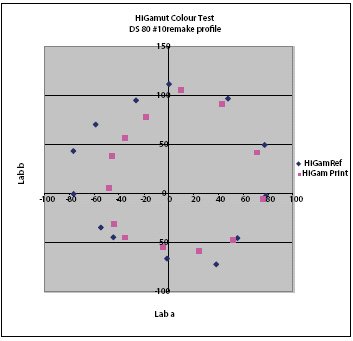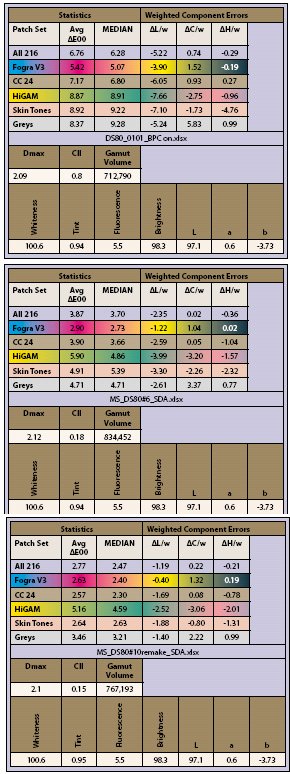articles/Printers/dnpds80printer-page2
DNP DS80 Dye Sublimation Printer - part 2 of 1 2 3
by Mike McNamee Published 01/04/2012

Note the pink squares in the left-hand quadrants of the graph are well inboard of the aim blue values indicating a weakness in the gamut in the green part of the spectrum.
A number of bespoke profiles were made and after a few false starts (profile software issues but that is another story!) we got the error down to 3.87?E00 using a 400-patch target. This audit print had weak highlight separation and so another profile was made using a 727-patch target and this dropped the average error down to 2.77?E00 and dramatically improved the skin tone error (down to 2.6?E00).
Overall then there is some improvement to be made in the supplied profile but when under control the printer seems capable of first-class performance. Because the dye sub is so different a technology we spent more time than usual comparing the statistics of the errors data.
Imagemaker
professional
A number of bespoke profiles were made and after a few false starts (profile software issues but that is another story!) we got the error down to 3.87?E00 using a 400-patch target. This audit print had weak highlight separation and so another profile was made using a 727-patch target and this dropped the average error down to 2.77?E00 and dramatically improved the skin tone error (down to 2.6?E00).
Overall then there is some improvement to be made in the supplied profile but when under control the printer seems capable of first-class performance. Because the dye sub is so different a technology we spent more time than usual comparing the statistics of the errors data.
The greens remain the weakest part of the gamut. The HiGAM Lab plot shows the greens more inboard than other tones. The highest hue error came from the 3/4 grey at (-) 4.7 units. The overall accuracy of the greys was poor in chroma and hue components but not (in the final profile) in luminance. With only chromatic colours with which to mix a grey this is probably not unexpected (the donor ribbon has only cyan, magenta and yellow to work with).
Metamerism
The index of metamerism as measured by the Colour Inconstancy Index provided one of the surprises of the testing. The value as measured between D65 and Tungsten A was one of the lowest values we have recorded, hovering around 0.15 to 0.18 ?E00 in the profiled (ie neutral!) print. This value was recorded in spite of the observation that the prints were strongly biased in domestic (low energy) lighting. After some experimentation we measured our ambient light spectrum and used that to measure CII - the value rose 37-fold to 5.54, one of the higher readings. The message is clear, these prints are very metameric when viewed in low grade, low energy lighting, a point that the user should be aware of when selling prints just in case a client queries the result. There is nothing you can do but at least you can explain to the client that it is their lighting not your print!

Please Note:
There is more than one page for this Article.
You are currently on page 2
- DNP DS80 Dye Sublimation Printer page 1
- DNP DS80 Dye Sublimation Printer page 2
- DNP DS80 Dye Sublimation Printer page 3
1st Published 01/04/2012
last update 18/07/2022 13:28:10
More Printers Articles
There are 61 days to get ready for The Societies of Photographers Convention and Trade Show at The Novotel London West, Hammersmith ...
which starts on Wednesday 14th January 2026







